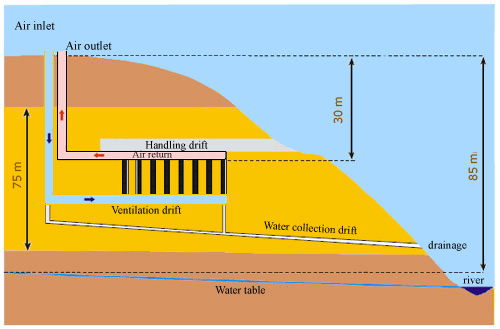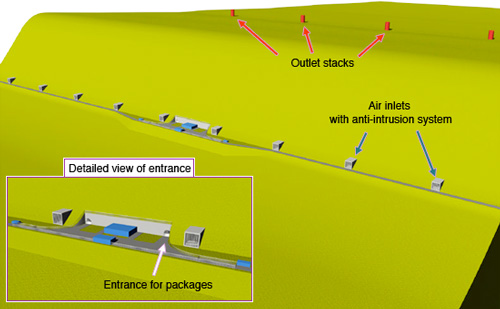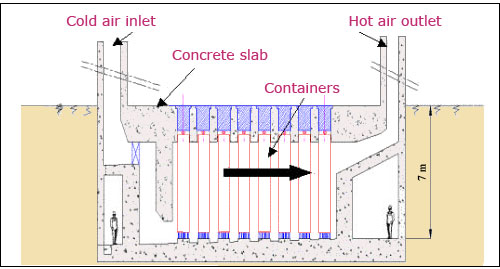Long surface storage concepts
Long-term surface and subsurface storage

Hillside storage
An installation in a hillside above the level of the water tablet provide drainage by gravity of the infiltration water without resorting to mechanical means. Location under a hill facilitates the circulation of air by natural convection, but the durability of the underground structures, especially concrete, is not proven. The shell of the installation, which consists of the rock already in place, can be considered stable in the very long term.
© CEA
Research into very long-term storage is a matter for the engineering sciences. To extend the life of existing industrial facilities, two solutions have been put forward: facilities built on the surface or dug into a hillside, and facilities at a depth of a few dozen metres.
Surface storage facilities can use the principles of existing installations. For subsurface storage facilities a site has to be defined.
Subsurface storage is better in the event of a plane crash or earthquake. Putting the storage facility into a hillside offers horizontal access, making the handling of the waste easier. Lorries can also access the storage site easily. The protection afforded by a rock formation would partly make up for the extra excavation costs. By choosing a hard rock such as granite or limestone, it would be possible to avoid putting in roof supports for the drifts.

Accessible underground installations
Long-term subsurface storage would increase resistance to external damage and earthquakes, but would not be suitable for intermediate-level long-lived waste (ILW-LL) for which forced ventilation would be required. For hot high-level waste packages, it has not been demonstrated that natural convection cooling would work everywhere, and forced ventilation might therefore be necessary.
© CEA
For the periods envisaged, dry storage would be used. The storage facilities would take high-level waste packages (vitrified waste or fuel assemblies) and packages of low- and intermediate-level long-lived waste (ILW-LL). Only high-level waste packages release very large amounts of heat (around 700 watts for a 35-year old package).
Separate solutions need to be considered for hot waste packages and intermediate-level waste packages, some of which can produce gases through radiolysis, dissociation of molecules by nuclear radiation (NB : radiolysis can generate release of hydrogen from organic materials). Removing the heat produced by hot waste packages is one of the issues to be resolved. Cooling is performed by means of natural convection due to the circulation of air. The effectiveness and reliability of this cooling mechanism must be guaranteed.
Further developments are needed as regards the durability of the materials, particularly concrete, the behaviour of the rocks at higher temperatures, ventilation and heat removal. On a different level, the maintenance and monitoring workload for future generations must be kept to a minimum to limit the consequences of losing control of the facilities. During the storage period the containment of the radioactive atoms must be guaranteed, and at the end of this period the packages must be removed. The longer the storage period, the more difficult it becomes to fulfil these imperatives. The designs produced by CEA’s engineers and researchers take these requirements into account.

Surface storage facility concept
This diagram of a surface storage facility for high-level waste makes use of the characteristics of existing storage facilities at La Hague. Storage facilities of this kind could reap the benefits of experience with facilities currently in service. A storage facility could be designed to be entirely on the surface or in half-buried concrete bunkers. There are options involving a sequence of different cooling methods, starting with water and moving on to natural convection.
© Clefs CEA
The long-term storage of high-level waste packages is based on three principles: that the packages are placed in metal containers, that the containers are cooled by natural convection, and that there is no humidity. The circulation of hot air, which removes any water vapour present, slows down the corrosion of the containers and extends their integrity.
In the view of France’s National Assessment Board, there is no justification for the extended storage of intermediate-level packages because they can be safely disposed of as soon as a deep geological repository is available. Even if the reliability of very long-term storage facilities were demonstrated, studies confirm that this kind of storage would continue to be an interim solution and that waste packages could not remain there indefinitely. The facilities have a limited life and require monitoring and maintenance. Even if this were minimal it would place a burden on future generations.
Other articles on the subject « Waste Outlooks »
Three research areas
Three complementary research areas The three research areas under the Bataille Act, later supplem[...]
Area 1: Partitioning
Sorting the radioelements in radioactive waste The separation, or partitioning, of the radioactiv[...]
Partitioning: results
Development of processes and extractant molecules The 2006 assessment of research into partitioni[...]
Advanced partitioning
Partitioning of nuclear waste: hot chemistry Advanced partitioning goes beyond just the partition[...]
Area 1: Transmutation
Area 1: Transmuting or transforming radioactive atoms Transmutation is the second part of researc[...]
Transmutation facilities
Fast reactors and Accelerator Driven Systems (ADS) The neutron, which easily penetrates nuclei, i[...]
Transmutation prospects
A far away objective for Generation IV and 2040… At the time of the first tests on the tran[...]
Area 2: Disposal
Research into deep geological disposal Can the nuclear industry’s final waste, which we cur[...]
Area 3: Long Surface Storage
Research into long-term storage Research into long-term storage is the second research topic in a[...]
Area 3: Conditioning
Area 3: Research into conditioning The conditioning of high-level and intermediate-level waste is[...]